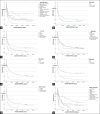Survival Outcomes in Malignancy-related Hypercalcemia: A Tertiary Care Single-center Experience
- PMID: 39156946
- PMCID: PMC11326661
- DOI: 10.37029/jcas.v10i2.675
Survival Outcomes in Malignancy-related Hypercalcemia: A Tertiary Care Single-center Experience
Abstract
Introduction: Malignancy-related hypercalcemia is commonly observed in patients with advanced stages of cancer. It is intricately linked with an unfavorable prognosis among oncology patients. This study aimed to evaluate survival outcomes among individuals diagnosed with hypercalcemia associated with malignancy.
Materials and methods: This retrospective analysis of 173 cancer patients with hypercalcemia who sought treatment at Shaukat Khanum Memorial Cancer Hospital and Research Centre, Lahore, Pakistan, between July 2019 and June 2020. This cohort of patients underwent a longitudinal follow-up for 2.5 years. To assess survival outcomes, the Kaplan-Meier tool was used to construct survival curves and estimate the survival probability over time. The significance of potential survival factors was evaluated using the log-rank test.
Results: All patients exhibited elevated levels of calcium. At admission, the cohort demonstrated varying degrees of hypercalcemia severity attributable to malignancy: Mild hypercalcemia was observed in approximately 61.3% of patients, moderate hypercalcemia in 23.7%, and severe hypercalcemia in 15% of cases. Among the total sample, most patients were female (54.9%), with a median age of 54. The primary tumor site most frequently observed was in cases of breast cancer (35.3%), wherein the prevalent histological subtype was lobular/ductal invasive carcinoma (34.1%). Most of the patients (93.6%) had an Eastern Cooperative Oncology Group (ECOG) performance status (ECOG) >1. In addition, the median overall survival for patients diagnosed with hypercalcemia was 51 days. Notably, there was a significant association between survival factors, including the primary site of malignancy (P = 0.001), bone metastasis (P = 0.04), severity and symptoms of hypercalcemia (P = 0.001), altered mental state (P = 0.001), albumin levels (P = 0.001), and ECOG (P = 0.001).
Conclusion: Malignancy-related hypercalcemia in patients with cancer is a significant predictor of an unfavorable prognosis. The aforementioned survival factors may have the potential to influence patient survival outcomes. Further studies on larger cohorts are warranted.
Keywords: Cancer; hematological malignancies; hypercalcemia; survival outcomes.
Copyright: © 2024 Ashfaq S, et al.
Figures



Similar articles
-
Analysis on survival and prognostic factors for cancer patients with malignancy-associated hypercalcemia.Asian Pac J Cancer Prev. 2014 Jan;14(11):6715-9. doi: 10.7314/apjcp.2013.14.11.6715. Asian Pac J Cancer Prev. 2014. PMID: 24377594
-
Malignancy-Related Hypercalcemia in Advanced Solid Tumors: Survival Outcomes.J Glob Oncol. 2017 Dec;3(6):728-733. doi: 10.1200/JGO.2016.006890. Epub 2017 Mar 15. J Glob Oncol. 2017. PMID: 29244985 Free PMC article.
-
Poor survival outcome with moderate and severe hypercalcemia in gynecologic malignancy patients.Int J Gynecol Cancer. 2009 Feb;19(2):178-85. doi: 10.1111/IGC.0b013e31819c0fd0. Int J Gynecol Cancer. 2009. PMID: 19395991
-
Hypercalcemia of malignancy and new treatment options.Ther Clin Risk Manag. 2015 Dec 4;11:1779-88. doi: 10.2147/TCRM.S83681. eCollection 2015. Ther Clin Risk Manag. 2015. PMID: 26675713 Free PMC article. Review.
-
Cancer-related hypercalcemia and potential treatments.Front Endocrinol (Lausanne). 2023 Mar 22;14:1039490. doi: 10.3389/fendo.2023.1039490. eCollection 2023. Front Endocrinol (Lausanne). 2023. PMID: 37033238 Free PMC article. Review.
References
-
- Jick S, Li L, Gastanaga VM, Liede A. Prevalence of hypercalcemia of malignancy among cancer patients in the UK:Analysis of the Clinical Practice Research Data link database. Cancer Epidemiol. 2015;39:901–7. - PubMed
-
- Burt ME, Brennan MF. Incidence of hypercalcemia and malignant neoplasm. Arch Surg. 1980;115:704–7. - PubMed
-
- Goldner W. Cancer-related hypercalcemia. J Oncol Pract. 2016;12:426–32. - PubMed
-
- Walker MD, Shane E. Hypercalcemia:A review. JAMA. 2022;328:1624–36. - PubMed
LinkOut - more resources
Full Text Sources
